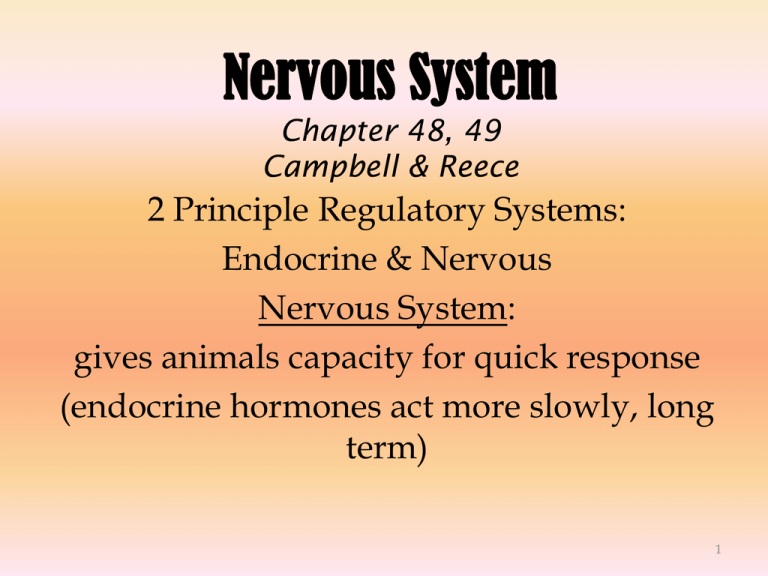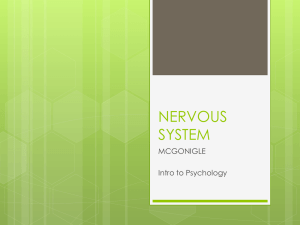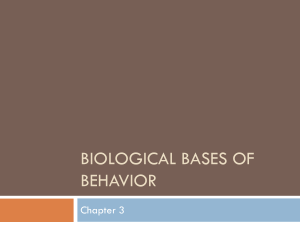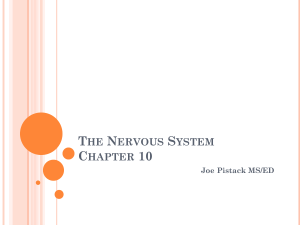
Nervous System
Chapter 48, 49
Campbell & Reece
2 Principle Regulatory Systems:
Endocrine & Nervous
Nervous System:
gives animals capacity for quick response
(endocrine hormones act more slowly, long
term)
1
THE EVOLUTION OF THE
NERVOUS SYSTEM
Comparisons: simple-->complex
• many invertebrates have neurons forming a
diffuse network; primitive brains (ganglia)
for responding to stimulus
• Vertebrates: nervous system is dorsal,
enclosed and protected by bones of vertebral
column and skull
• Trend is toward increased cephalization of
control in the brain
2
ORGANIZATION OF THE
VERTEBRATE NERVOUS
SYSTEM
The Nerve Cell, "neuron":
3
•
(1) CNS = spinal cord and brain
•
(2) PNS = (peripheral nerves): all other nerves (branches off CNS)
– (a) sensory (afferent) NS: carries impulses to CNS
– (b) motor (efferent) NS: carries impulses from the CNS, typically to
muscles and glands
– somatic NS- controls skeleton muscle (voluntary)
– autonomic NS- controls smooth and cardiac (involuntary)
muscles and glands
» sympathetic NS- stimulate
» parasympathetic NS- inhibit
organizational chart
4
The Brain
• Adult brain weighs approx. 1.4 kg (~3 lbs)
and contains about 100 billion neurons
• capable of carrying out many
simultaneous operations
• made of multiple lobes, parts
5
The CEREBRUM
•
•
•
•
the largest portion of the human brain (80% of brain by volume)
it is here that things like perception, imagination, thought, judgment, and
decision occur
divided into right and left halves (hemispheres), connected by a tightlypacked mass of nerve fibers, the corpus callosum
"Cross-wired": right side of brain receives messages and sends signals to
left side of body
Left / Right Hemispheres: responsible for
different functions;
examples: injury to left side of brain results
in speech impairment (aphasia); right side =
musical talent...
•white matter: myelinated axons, inner
portion of cerebrum
•grey matter: unmyelinated axons,
make up outer (cortex) region of
cerebrum
6
Cerebrum, continued
• Internal structure- 3 hollow bulges- "ventricles" filled
with Cerebrospinal Fluid
• The wrinkly, folded surface of the cerebrum -- the
cerebral cortex -- is about 2 to 4 mm thick
• The wrinkles (convolutions) have "ridges" which are
called gyri (singular: gyrus), and "valleys" which are
called sulci (singular: sulcus).
7
Some of the sulci are quite pronounced and long, and
serve as convenient boundaries between four areas of
the cerebrum called lobes.
8
9
The furthest forward is the
frontal lobe.
It seems to be particularly important:
• this lobe is responsible for voluntary movement
and planning
• is thought to be the most significant lobe for
personality and intelligence
• At the back portion of the frontal lobe, along the
sulcus that separates it from the parietal lobe, is
an area called the motor cortex.
• In studies with brain surgery patients,
stimulating areas of the motor cortex with tiny
electrical probes caused movements.
• It has been possible for researchers to actually
map out the motor cortex quite precisely.
• The lowest portions of the motor cortex, closest
to the temples, control the muscles of the mouth
and face.
• The portions of the motor cortex near the top of
the head control the legs and feet.
10
Behind the frontal lobe is the
parietal lobe
It includes an area called the
somatosensory cortex, just behind
the sulcus separating this lobe from
the frontal lobe.
• Again, doctors stimulating points
of this area found their patients
describing sensations of being
touched at various parts of their
bodies.
• Just like the motor cortex, the
somatosensory cortex can be
mapped, with the mouth and face
closest to the temples and the legs
and feet at the top of the head.
11
At the side of the head is the
temporal lobe
The special area of the
temporal lobe is the auditory
cortex.
• As the name says, this area is
intimately connected with the
ears and specializes in hearing.
• It is located near to the
temporal lobe's connections
with the parietal and frontal
lobes.
12
At the back of the head is the
occipital lobe
• At the very back of the occipital
lobe is the visual cortex, which
receives information from the eyes
and specializes, of course, in vision.
• The areas of the lobes that are not
specialized are called “association
cortex”.
• Besides connecting the various
sensory and motor cortices, this is
also believed to be where our
thought processes occur and many of
our memories are ultimately stored.
13
The Brainstem
• Spinal cord is
continuous to the
brainstem
• "Brainstem" controls
muscles and glands in
head, autonomic
regulatory
functioning (resp.,
B.P.)
14
Upper Brainstem
(see figure 50-4, pp. 1006) "Diencephalon"
• Thalamus:
– 2 egg-shaped orbs;
– main relay center between
brainstem and cerebrum
– processes sensory information
• Hypothalamus:
– just below thalamus;
– thermostat for mammals
– maintenance of homeostasis
– source of several releasing
hormones
The Limbic System: includes parts of the
thalamus, hypothalamus, and deep
cerebrum.
Responsible for EMOTION, MOTIVATION,
MEMORY, and DRIVES (sex, hunger, thirst,
pain, pleasure, anger).
Emotions are translated into actions.
15
Lower Brainstem:
extension of the spinal cord
•
midbrain: mainly for relay for visual and
auditory information; reflex center
•
pons: relay center between cerebral
hemispheres and the cerebrum and
cerebellum
•
medulla oblongata: controls autonomic
homeostatic activities, like heartbeat,
respiration, etc.
•
reticular formation:
– controls consciousness, arousal
– filters incoming stimuli and discriminates
the "important" from the "unimportant".
16
The Cerebellum
• The cerebellum is involved in the coordination of voluntary motor
movement, balance and equilibrium and muscle tone.
• It is located just above the brain stem and toward the back of the
brain. It is relatively well protected from trauma compared to the
frontal and temporal lobes and brain stem.
Cerebellar injury results in movements
that are slow and uncoordinated.
Swaying and staggering when walking,
and sometimes slurred speech can
occur when damaged.
17
PROTECTION OF THE BRAIN
(pp. 1007)
• surrounded by three protective layers,
called MENINGES.
– dura mater (outermost)
– arachnoid layer
– pia mater (innermost)
• also cushioned by a clear fluid,
CEREBROSPINAL FLUID, which also fills
the cavities (ventricles) within the brain.
18
THE SPINAL CORD
(pp. 1008)
• a long column of nerves that
run down the center of the
vertebral column
• outer sheath of white matter
(mostly axons), surrounding
inner core of grey matter (cell
bodies of neurons)
• 31 pairs of spinal nerves
branch outward, carrying
messages to/from PNS
19
Transmission of Nerve Impulses
•
•
•
•
Neurons: the functional units of the Nervous System surrounded and insulated by the other nerve
cells
Axons and Dendrites = "nerve fibers"
dendrites pick up/generate nerve impulses, then pass it through the cell body, and down the axon.
Myelin sheath: fatty insulation. In the PNS, this insulating material is produced by cells called
Schwann cells.
–
•
insulator, speeds up impulses (100 m/sec, 225 mph)
gaps in the myelin sheath are called the nodes of Ranvier.
–
impulse jumps from node to node
20
TYPES OF NEURONS:
• Sensory neurons: initiate a nerve impulse
when triggered by a stimulus (dendrites
embedded in sense organs)
• Interneurons: (association neurons) relay
nerves, transfer impulses to/from PNS
to/from CNS ("connectors")
• Motor neurons: axon ends in a muscle or
gland. These trigger a response to a
stimulus.
21
22
Synapses
• junctions across which neurons
communicate with each other
(electrical/chemical)
• impulse must be carried across
synaptic cleft by a "chemical bridge"
(neurotransmitter) ex: acetylcholine
or noradrenalin
synapse animation
• Neurotransmitters are made in cell body and are stored in synaptic
vesicles at end of nerve fiber
• Ca 2+ allows neurotransmitter to be released into synaptic cleft, and
attaches to receptor sites on adjacent nerve fibers
• acetylcholine is quickly broken down with enzyme (cholinesterase)
23
THE NERVE IMPULSE
• The Ionic Basis of Action Potential
• At rest, [K+] greater inside nerve fiber;
[Na+] greater outside nerve fiber.
• Resting Potential- slight excess of negative
charge inside membrane from outward
diffusion of K+
• Action Potential- portion of membrane
becomes momentarily permeable to Na+
ions (flow inward), accompanied by an
outward flow of K+
24
action potential animation
animation of ion flow through gated channels
"Sodium-Potassium Pump": reverses (resets) polarity (at nodes) Na/K Pump
animation
25
The Senses
• Sensory organs (eyes, ears, skin, etc.)
allow us to detect, and then respond to
stimulus
• Survival depends on evaluating and
reacting to changing situations around us.
26
The Senses
TYPES OF RECEPTORS:
• Mechanoreceptors: touch, position, hearing
• Chemoreceptors: taste and smell
• Photoreceptors: vision, light
• Thermoreceptors: heat
These are all nerve endings (dendrites) embedded in body
parts, sense organs
A different part of the brain is responsible for
interpretation of each sense, for example, the temporal
lobe of the cerebrum is the hearing/sound center...
27
Anatomy of the Ear animation
1. Human ear has three divisions: an outer,
middle, and inner ear.
2. Outer ear consists of pinna (external flap)
and the auditory canal.
a. Auditory canal opening is lined by fine
hairs that filter air.
b. Modified sweat glands in auditory
canal secrete earwax to guard ear against
foreign matter.
3. Middle ear begins at tympanic membrane
and ends at a bony wall with membranecovered openings (oval window and
round window).
a. It contains ossicles: malleus
(hammer), incus (anvil), and stapes
(stirrup).
b. Malleus adheres to tympanum; stapes
touches oval window.
c. Auditory (eustachian) tube extends
from middle ear to pharynx to equalize
inside and outside air.
4. Inner ear has three regions: semicircular
canals, vestibule, and cochlea.
5. Cochlea resembles a snail shell because it
spirals.
The Ear
1) detection of sounds - hearing.
2) detection of movement and the position,
of the head - balance.
28
Process of Hearing
animation
1.
2.
3.
4.
5.
6.
7.
8.
9.
10.
11.
12.
13.
14.
Process of hearing begins when sound waves enter auditory canal, causing ossicles to vibrate.
Sound is amplified 20 times by size difference between tympanic membrane and oval window.
Stapes strikes membrane of oval window, passing pressure waves to fluid in cochlea.
Vestibular canal connects with tympanic canal, which leads to oval window membrane.
Three canals are located within cochlea: vestibular canal, cochlear canal, and tympanic canal.
Hair cells of the spiral organ (organ of Corti) synapse with nerve fibers of cochlear (auditory)
nerve.
When stapes strikes membrane of oval window, pressure waves move from vestibular canal to
tympanic canal and across basilar membrane, and the round window bulges.
Basilar membrane vibrates up and down, bending stereocilia of hair cells embedded in tectorial
membrane.
Nerve impulses in auditory nerves travel to brain stem.
In auditory areas of cerebral cortex, this is interpreted as sound.
Spiral organ is narrow at its base and widens at tip; each part is sensitive to different pitches.
Nerve fibers from each region (high pitch @ base or low pitch @ tip) lead to slightly different
regions of brain producing sensation of pitch.
Sound volume causes more vibration; increased stimulation is interpreted as louder sound
intensity.
Tone is interpretation of brain based on distribution of hair cells stimulated.
29
Sense of Balance
• Sense of balance (equilibrium) utilizes the semicircular canals.
• Semicircular canals are oriented at right angles to one another in
three different planes.
• These tubes are filled with a fluid, and are lined with tiny cilia,
tipped with calcium carbonate granules (otoliths)
• Displacement of this fluid (ex: tilting) causes movement in the cilia,
causing them to bend; the degree and direction of this bending is
then interpreted by the brain.
– Continuous movement of fluid in semicircular canals causes vertigo (motion
sickness).
– By spinning and stopping, we see a room still spin; this indicates vision is
involved in balance.
30
The Eye
Human eye is an elongated sphere 2.5 cm in diameter with three layers.
Sclera is outer, white fibrous layer that covers most of eye; it protects and supports
eyeball.
Cornea is a transparent part of sclera at front of the eye that is window of the eye.
Middle, thin, dark-brown layer is choroid containing many blood vessels and pigments
absorbing stray light rays.
To front of eye, choroid thickens and forms ring-shaped ciliary body and finally becomes
the iris that regulates size of the opening called a pupil.
Lens divides eye cavity into two portions: aqueous humor fills anterior cavity and
vitreous humor fills posterior.
Inner layer, retina, contains photoreceptors:
– Rod cells: about 125 million; contain rhodopsin, a pigment sensitive at low light
levels (Vit A)
– Cone cells: about 7 million; stimulated by bright light (sharp images and colors)
– Fovea centralis is a small area of retina that contain only cones; this area
produces acute color vision in daylight.
– Cone cells are barely sensitive at low intensity at night; at this time, the rods are
still active.
31
The Eye
32










